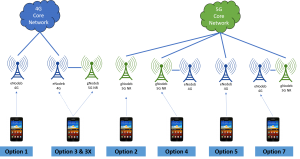5G Options
Kieran Arnold


What exactly is a 5G connection? And are they all the same? Our Director of Ubiquitous Connectivity and 5G Step-Out Centre Manager, Kieran Arnold, explains…
5G is a smorgasbord of migration options. While we all say 5G has finally arrived with all the amazing features like network slicing, eMBB (enhanced mobile broadband), URLLC (ultra-reliable, low-latency communications) and mMTC (massive machine to compute), where we stand today is the addition of 5G New Radio (5GNR) attached to a 4G Evolved Packet Core (EPC); otherwise known as Option 3 Non-standalone 5G (catchy, right?).
What does this offer? A cost-effective version of 5G that network operators can use to scope out the demand for the connectivity upgrade. What does it not offer? Network slicing, which allows specific quality of service to be delivered to particular user types.
Back to the above-mentioned smorgasbord…below I have included a diagram showing the main migration or deployment options and how they relate to Non-Standalone (NSA) and Standalone (SA) versions, in its simplest form.

The options using dual connectivity are grouped together under the term non-standalone to indicate that 5G radio access technology (NR) and LTE are used simultaneously to provide radio access. Options where only one radio access technology is in use are referred to as standalone.
In conclusion, there are many options for 5G connectivity which means that networks can be tailored to the service required from them. Currently, option 3 is the simplest to implement and so is the ideal option for operators to begin with, and for research and development organisations to test new features on. However, to fully utilise the new features that 5G can offer, a standalone 5G connection will be required – and we’re currently developing what is expected to be the UK’s first standalone 5G network in our 5G Step-Out Centre!